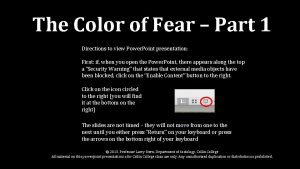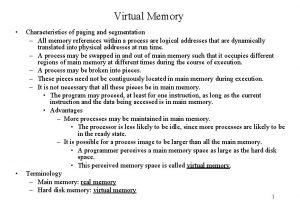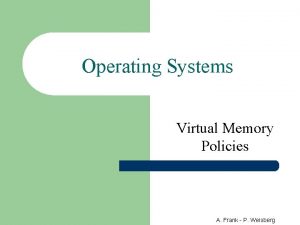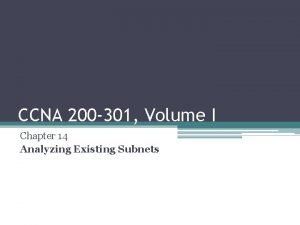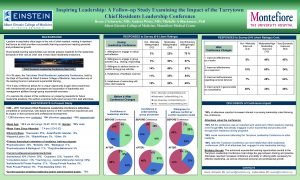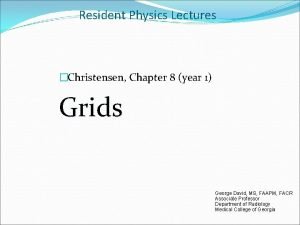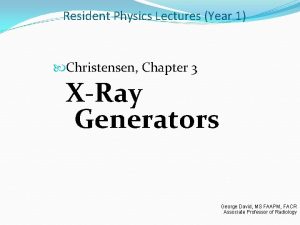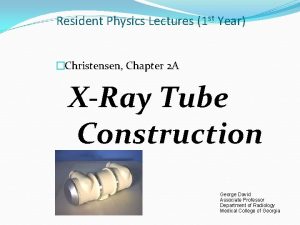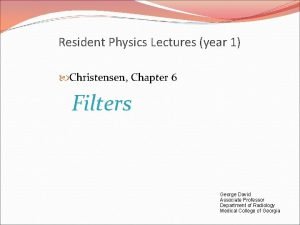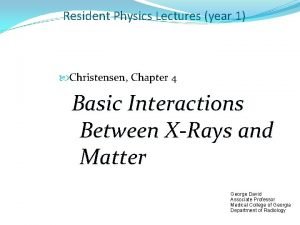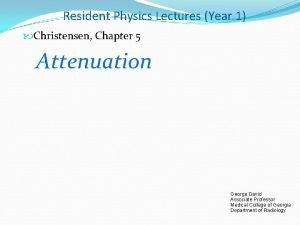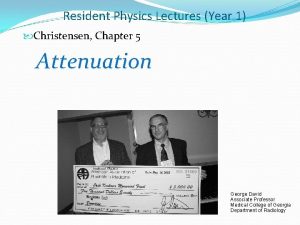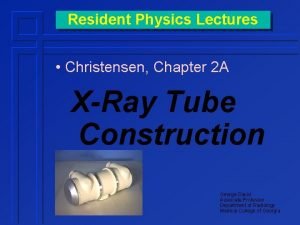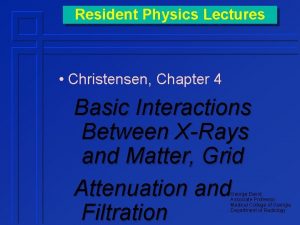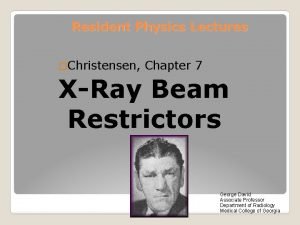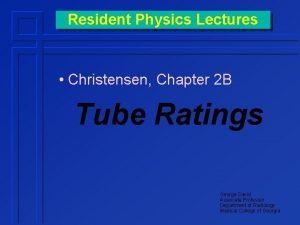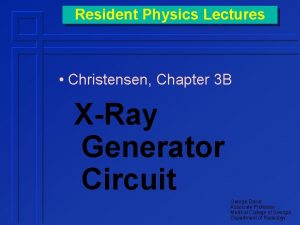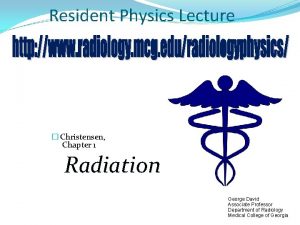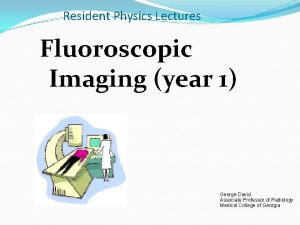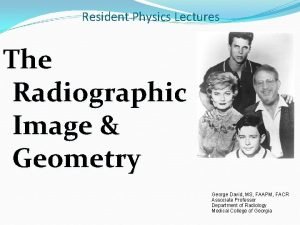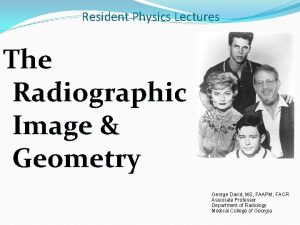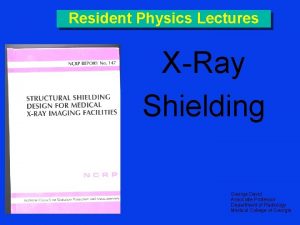Resident Physics Lectures Year 1 Christensen Chapter 3

























































- Slides: 57

Resident Physics Lectures (Year 1) Christensen, Chapter 3 X-Ray Generators George David, MS FAAPM, FACR Associate Professor of Radiology

Requirements to Produce X-Rays Filament Voltage High Voltage anode + high voltage source filament voltage source

X-Ray Generator Supplies electrical power to x-ray tube high voltage between anode & cathode filament voltage anode + high voltage source filament voltage source

X-Ray Generator Controls exposure timing Turns exposure on and off Filament heated before exposure High voltage switched on and off

Voltage Supplied US Commercial Power Home 120 / 240 V Industrial 480 V 240 V

Home Voltage Required Most stuff: 120 V AC / Dryer: 240 V Door bell: 15 V Computer 5 V X-Ray Filament: 8 -12 V High voltage: 40 -150 k. V (40, 000 V – 150, 000 V)

Problem: Voltages Don’t Match Voltage Supplied Voltage Required

Transformers Devices that allow voltage to be changed to any desired value

Current Flow and Magnetic Fields Magnetic field surrounds conductor carrying electric current Magnetic field concentrated by coiling conductor Magnetic Field N Magnetic Field S Current Flow

Transformer Construction 2 coils of wire not in electrical contact with each another When electric current passed through primary coil magnetic field develops around primary coil Secondary coil senses magnetic field Magnetic Field Current Flow

Transformer Coil Designations Incoming AC Power Primary Coil primary coil to which power applied secondary coil which senses magnetic field of primary coil Secondary Coil(s)

Transformer Coils When secondary coil feels changing (increasing or decreasing) magnetic field of primary coil power induced in secondary coil no physical connection Incoming AC Power Primary Coil Secondary Coil(s)

Turns Ratio Definition TR=NS / NP number of windings of secondary coil divided by number of windings of primary coil 40 / 20 for transformer below NP = 20 NS = 40

Transformer Theory Transformers only work when primary coil current / magnetic field is changing Input DC Voltage & Current Zero Output Voltage Time Input AC Output

Transformer Theory Transformers alter both voltage & current of AC waveforms Voltage in secondary can be > or < voltage in primary Input AC Voltage & Current Output AC Voltage & Current

Transformer Law Voltage Ratio = Turns Ratio # Sec. Coils Turns Ratio = --------# Prim. Coils NS VS ----- = ----NP VP Sec. Voltage = ---------Prim. Voltage

Transformer Types Step down Transformer # primary coils > # secondary coils primary voltage > secondary voltage u Step up Transformer • # primary coils < # secondary coils • primary voltage < secondary voltage

How does a transformer increase voltage with no source of energy?

Power ¨ Power is rate of energy usage ¨ Power defined as Voltage X Current ¨ Units Voltage => Volts Current => Amps Power => Watts • Voltage => Kilovolts • Current => milliamps • Power => Watts

Power = Voltage X Current Transformer primary power = secondary power transformer neither creates nor consumes power Power. PRIM = Power. SEC VPRIM X IPRIM = VSEC X ISEC

Transformers Power = Voltage X Current Electrical power not changed Current exchanged for voltage Voltage goes up – current goes down Voltage goes down – current goes up

Transformer Law (cont. ) Current ratio is inverse of voltage ratio # Sec. Coils Sec. Voltage Prim. Current --------- = ----------------# Prim. Coils Prim. Voltage Sec. Current NS VS IP ----- = ----NP VP IS VPRIM X IPRIM = VSEC X ISEC

Transformer Ratio = Output voltage / Input voltage Most transformers have fixed ratios X-Ray requires variable ratios Accommodate selection of different k. V’s

Autotransformer Taps Only one winding Incoming AC voltage connected across coils primary Output voltage proportional to # coils between taps secondary Input NP Primary NS Secondary

Autotransformer Voltage law for autotransformers same as for transformers Variable ratio transformer Secondary voltage adjustable by moving to different tap changes # secondary coils NS NS VS ----- = ----NP VP Input NP Primary NS

Generator Components control console k. Vp adjust m. A adjust or m. As adjust time adjust transformer high voltage (step up) filament low voltage (step down) electronics cabinet support circuitry

X-ray Circuit Timer Circuit Autotransformer m. A selector Rectifier Circuit + Line High Voltage Transformer Filament Transformer

Timer Circuit Rectifier Circuit Autotransformer m. A selector + Line High Voltage Transformer Filament Transformer Line Incoming line voltage connected to generator through a circuit breaker. Typ. 220 -240 volt AC single phase 240, 480 volt AC three phase

Circuit Breaker Generator connected to power line through a circuit breaker Limits current from power line to generator Allows generator to be disconnected from power line Incoming Power Line Generator Circuit Breaker

Line Autotransformer m. A regulator Timer Circuit Rectifier Circuit Fixed ratio + Variable ratio High Voltage Transformer Filament Transformer • Auto transformer • Variable ratio transformer allowing operator to specify k. Vp • High voltage transformer • Boosts output of autotransformer by fixed ratio

Timer Circuit Autotransformer m. A regulator Rectifier Circuit + Line High Voltage Transformer Filament Transformer Timer • Starts & stops exposure • Turns transformer primary (low voltage) on & off

Exposure Timing Manual Operator sets time Automatic (Phototimed) Equipment measures radiation Terminates exposure when designated radiation measured

Phototiming Detector in front of receptor Must be essentially invisible Radiation Sensor Grid Image Receptor

Phototiming Fields 1, 2, or 3 fields may be selected individually or in combination proper positioning critical

Timer Circuit Rectifier Circuit Autotransformer m. A regulator + Line High Voltage Transformer Filament Transformer Timer • Develops DC high voltage for x-ray tube

High Voltage Transformer Grounded metal box filled with oil electrical insulator Function Develops proper high voltage for tube Also contains rectifier circuit

New Challenge Transformers only produce AC X-ray tube requires DC high voltage

Rectification Allows current flow only in one direction Transformers only work with alternating current (AC) Rectifier changes alternating current output of high voltage transformer to direct current DC voltage applied to tube

Rectifier Also called diode Diode is two-component device cathode anode Cathode Anode

Diodes are One Way Streets for Electric Current Allows current to flow from cathode to anode Blocks current from flowing from anode to cathode C A

Diodes: A one-way valve for current Allow current to flow through diode in cathode to anode direction acts like closed switch diodes connected like this said to be “forward biased” biased Battery + - Load (tube)

Diodes: A one-way valve for current Does not allow current to flow through diode in anode to cathode direction acts like open switch diodes connected like this said to be “reversed biased” biased + X

Rectifiers (Diodes) converts AC to pulsating DC Configurations solid state sticks small diodes placed end to end materials selenium silicon (most common today) AC many DC

Three-Phase Generators Commercial power generally delivered as three phase 3 phases Each phase has same waveform but 120 o apart in time Single Phase Power Three Phase Power

Three Phase Rectification 3 Phase Power Rectification Three Phase Rectification Circuit follows highest of 3 Phases

Timer Circuit Autotransformer m. A regulator Rectifier Circuit + Line High Voltage Transformer Filament Transformer m. A regulator • Circuitry for m. A selection • Corrects m. A during exposure.

Timer Circuit Rectifier Circuit Autotransformer m. A selector + Line High Voltage Transformer Filament Transformer Changes AC voltage to smaller voltage required by filament (8 -12 volts typical)

Power Storage Generators Use batteries Application Remote locations Inadequate power from power line or power line not accessible Outlet inaccessible

Battery-Powered Generators Batteries used for x-ray transport Independent of power line during exposure Disadvantages Batteries must be charged Batteries maintenance Heavy Battery’s DC converted to AC for high voltage transformer to operate

Medium (or high) Frequency Generators higher frequency square wave voltage sent to primary of high voltage transformer Conventional generators use power line’s sine wave very efficient transformer & generator very small

Medium Frequency Generator Operation incoming AC converted to DC AC DC

Medium Frequency Generator Operation Smooth pulsating DC to constant voltage Pulsating DC Constant DC

Medium Frequency Generator Operation Regulate smooth DC to required voltage level for k. Vp requested Constant DC Exposure-level DC

Medium Frequency Generator Operation DC converted (chopped) to AC Exposure-level DC Chopped AC

Medium Frequency Generator Operation AC sent to transformer primary normal transforming & rectification high voltage smoothing

Medium Frequency Generators Advantages conducive to computer control immune to power line fluctuations low ripple small size of electronics & transformer small enough to spin on CT gantry Today’s trend in generators

Surrender We give up!
 Yelena bogdan
Yelena bogdan Pab ankle fracture
Pab ankle fracture Frcr physics lectures
Frcr physics lectures Heel effect
Heel effect Describe the care team and the chain of command
Describe the care team and the chain of command Hanau quint equation
Hanau quint equation Teri christensen
Teri christensen Martin juul christensen
Martin juul christensen Protruziv kondil yolu eğimi
Protruziv kondil yolu eğimi Color of fear
Color of fear Tommy christensen gu
Tommy christensen gu Factors affecting balanced occlusion
Factors affecting balanced occlusion Gerald barnbaum
Gerald barnbaum Dani christensen
Dani christensen Leaving year 6 poem
Leaving year 6 poem Resident set management
Resident set management Resident retention
Resident retention Resident set management
Resident set management Income means
Income means Divine intervention biostats
Divine intervention biostats Resident lifecycle
Resident lifecycle Attending vs resident
Attending vs resident Misappropriation of resident property
Misappropriation of resident property A helpful way for an na to respond to hallucinations is to
A helpful way for an na to respond to hallucinations is to Chapter 10 positioning transfers and ambulation
Chapter 10 positioning transfers and ambulation Partially resident textures
Partially resident textures Acgme resident survey
Acgme resident survey Employment of non-resident aliens in the philippines
Employment of non-resident aliens in the philippines Orientation and resident rights quiz
Orientation and resident rights quiz Resident customer service
Resident customer service Define resident flora
Define resident flora Magic mask
Magic mask Resident assessment instrument definition
Resident assessment instrument definition Tarrytown chief resident conference
Tarrytown chief resident conference Resident alien telluride
Resident alien telluride Resident and family engagement
Resident and family engagement Resident and family engagement
Resident and family engagement Acgme resident survey questions
Acgme resident survey questions Rick trebino
Rick trebino Neonatology lectures
Neonatology lectures Data mining lectures
Data mining lectures Advanced medicinal chemistry
Advanced medicinal chemistry Uva ppt template
Uva ppt template Ludic space
Ludic space Step wise project planning
Step wise project planning Molecular biology lecture
Molecular biology lecture Radio astronomy lectures
Radio astronomy lectures Dr sohail lectures
Dr sohail lectures Utilities and energy lectures
Utilities and energy lectures Introduction to web engineering
Introduction to web engineering How to get the most out of lectures
How to get the most out of lectures Cs106b lectures
Cs106b lectures Blood physiology guyton
Blood physiology guyton Aerodynamics lectures
Aerodynamics lectures Theory of translation lectures
Theory of translation lectures Power system lectures
Power system lectures What is text linguistics
What is text linguistics Translation 1
Translation 1









